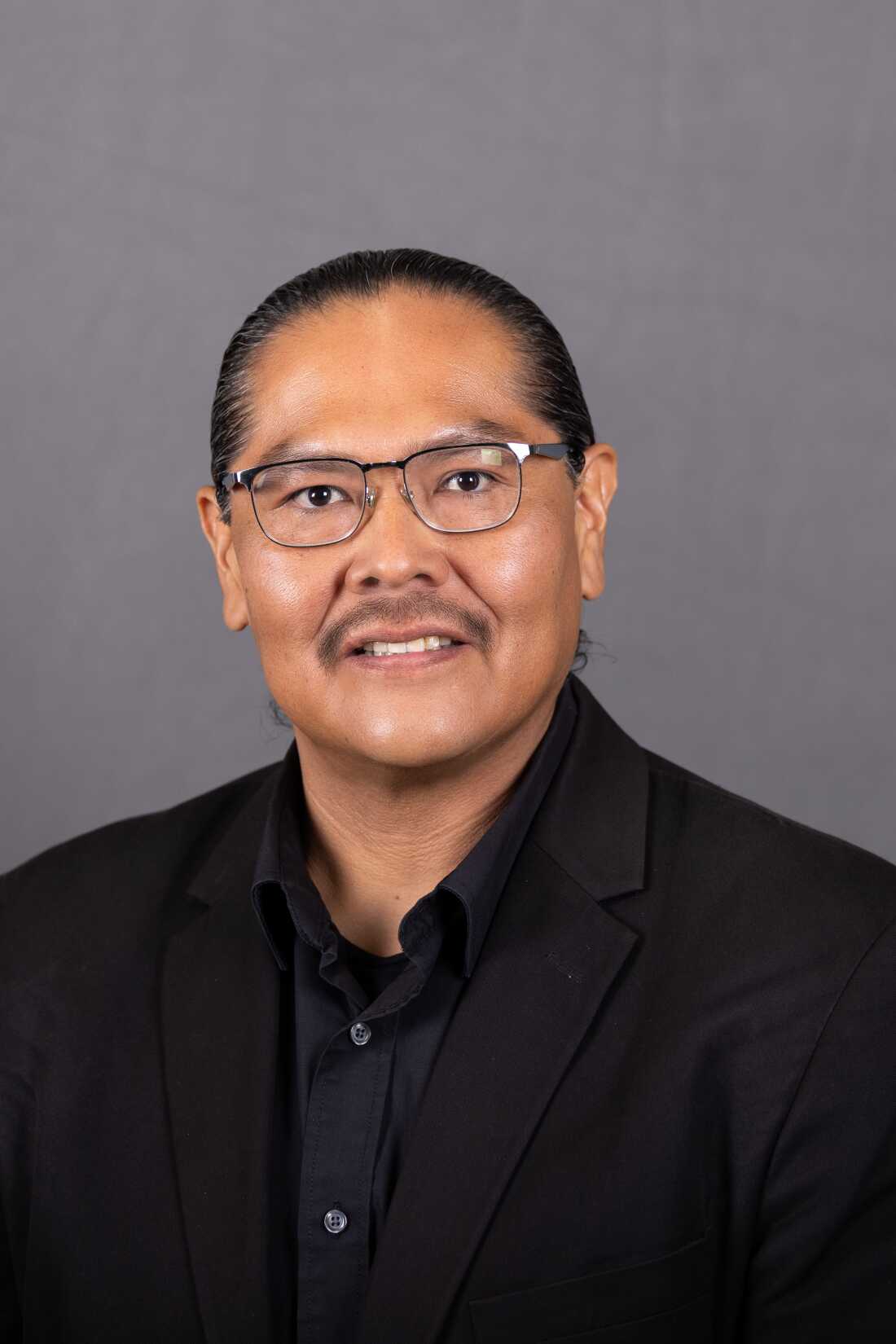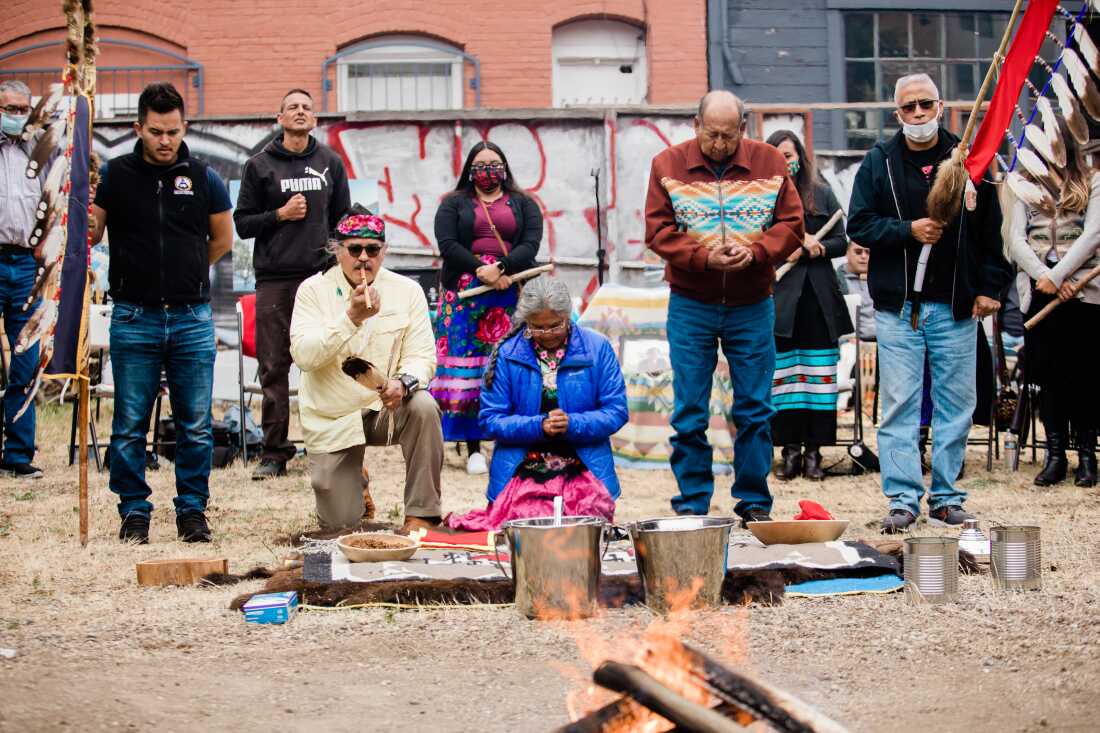
Drum circle at the Friendship House in San Francisco. Friendship House is an Indigenous-led treatment program that provides culturally relevant care.
San Francisco Chronicle/Hearst Newspapers/Getty Images
hide description
toggle caption
San Francisco Chronicle/Hearst Newspapers/Getty Images
Emery Tahy of San Francisco knows firsthand the struggles of addiction and recovery — a journey that, for him, is connected to his experience as a Native American.
In his 20s, Tahy lived on the streets of Phoenix battling severe depression and alcoholism. About four years ago, Tahy said, he was on the verge of suicide when his siblings stepped in and sought court-ordered treatment.
While Tahy was detoxing at a psychiatric facility, he learned about Friendship House, a recovery treatment program led by a San Francisco Native. As soon as he was released from a hospital in Arizona, he headed to California.
“I knew right away that I was in the right place,” said Tahy, 43. “The traditional healer made me pray. They shared songs with me. They put me in a sweat room and I could relate to those celebrations. And from that day forward, I was able to restore my spiritual and cultural upbringing.”
Now, for the first time, Medicaid in California, Medi-Cal, as well as Arizona, New Mexico and Oregon, aims to cover health services such as music therapy, sweatshops, and dance to help with physical and mental health. .

The Centers for Medicare & Medicaid Services announced the move this week. It is a two-year pilot program operating in Indian health service centers, tribal centers and urban institutions in India.
In California, two new intervention categories will be covered by the Medi-Cal expansion. People with substance abuse problems can seek treatment from traditional healers who provide traditional services, or, they can work with trusted people within the tribe such as elected officials or spiritual leaders. who provide psychological support, trauma counseling and recovery guidance. California is home to the largest population of African Americans, and Gov. Gavin Newsom said in a press release announcing the expansion that the government is “committed to healing the historic wounds caused by race, including the health inequities of the Native American community.”

Emery Moves
Maira Garcia
hide description
toggle caption
Maira Garcia
Seeking relief from a problem
Tahy’s battle with alcoholism began when he was a young child. He said he drank his first beer when he was 4 years old, surrounded by parents, uncles, aunts, and grandparents who drank heavily. Navajo Nation.
“I’m a full-blooded American Indian,” said Tahy, recounting the struggles he faced in his youth. “Growing up I had a lot of prejudice, racism and discrimination. I wasn’t proud of who I was. I feel like drugs and alcohol were a way to deal with that shame. Alcohol helped me to be sociable and it gave me courage.”
During his teenage years, Tahy drank and started playing marijuana, cocaine and crystal meth. He said that during this time, his family developed a good relationship with his culture.
Tahy said: “I was always encouraged by my grandparents, on my mother’s side, to learn and connect with traditional Navajo ways of life. “There was a deep connection with family activities, land and festivals associated with the changes of the seasons.”
Tahy’s story is not unique. Native American populations have some of the highest rates of addiction and excess mortality in the country, and health experts have argued that Western medicine alone cannot cure the problems of substance abuse in the American Indian population.

Native American organizations gathered at Friendship House in 2022 to pray for the success of The Village SF, a health care and community center for Native Americans in San Francisco.
Friendship House
hide description
toggle caption
House of Friendship
This tragedy is compounded by centuries of historical suffering.
Roselyn Tso, who runs the federal Indian Health Service, or IHS, has encouraged Medicaid to provide traditional healing. He said in a press release from CMS that “these methods have guaranteed the lives of our people for generations and continue to serve as an important link between culture, science and health in many communities. ours.”
So far some Native Americans have had access to health care through IHS rebates, Tribal resources, various pilot programs, and grants. This is the first time Medicaid will cover these services.
Bridging tradition and modern medicine
Although clinical approaches such as detox, medication-assisted treatment and behavioral therapy are important for treating substance use disorders, they often fail to address the cultural and spiritual needs of Indian patients.
“Cultural practices, by nature, are inclusive,” said Damian Chase-Begay, an American Indian health researcher at the University of Montana. They affect a person physically, mentally, spiritually and emotionally. They benefit all people, not just physical symptoms.”
Studies have shown that combining traditional methods in addiction treatment can lead to higher participation and better recovery results, although most of the current research is qualitative, not quantitative.
For many years, health workers dedicated to the Indian population have been struggling with the limitations of what insurance will cover. Medi-Cal, the federal Medicaid program for low-income residents, pays for medical prescriptions or speech therapy, but traditional treatment options were often excluded, leaving many patients with Native Americans do not have access to treatment consistent with their traditional values.
“What California is saying now under Medi-Cal is exactly what our Native citizens have been asking for coverage for years,” Chase-Begay said. “This kind of support, if it existed, would have helped stop depression and substance abuse years ago. I’m so glad it’s here now, but it’s been a long time coming.” and there.”
The new Medi-Cal plan will take effect next year, and Indian Health Service providers in eligible states will be able to request reimbursement for these services beginning in January 2025. It will expire at the end of 2026 unless extended.
“It’s important that we respect our traditional healing methods,” said Kiana Maillet, a licensed healer in San Diego and a member of the Lone Pine Paiute-Shoshone Tribe. “Cultural healing is deeply rooted in our culture. Without it, we are missing part of who we are.”
As for Tahy, he has not touched a drop of alcohol since he started treatment at Friendship House. He now has a full-time job as an analyst at the Native American Health Center in San Francisco. He will soon complete a master’s degree in American Indian studies. And, a few months ago, he finished the San Francisco marathon.
#Medicaid #cover #traditional #medicine #Native #Americans #states